By Ctein
After the recent TOP print sale, I decided to splurge on a trio of fast prime lenses for my Olympus Pen E-P1. Eventually I will get around to reviewing the Olympus 12mm ƒ/2 and 45mm ƒ/1.8 lenses, but I'm starting out with the Rokinon 85mm ƒ/1.4 telephoto. Why? Well, because that's the one I got first and have been able to put through its paces. You'll get the other two reviews by the end of the year, I promise.
This is the sort of lens that helps justify the existence of a format like Micro 4/3. On a full-frame camera, this is a modest telephoto of modest quality at a modest price ($270). On a micro 4/3 camera it's the equivalent of a 170mm ƒ/1.4 lens. Try paying for one of those for your full-frame camera, why don't you? Too rich for my blood. Even tossing in the cost of the 4/3-to-Micro 4/3 adapter that I didn't yet own, it wasn't big bucks for such an extraordinary combination of focal length and aperture.
Some negatives: as you'd expect it's huge and heavy; at 600+ grams, it significantly outweighs the camera body. It's also bigger. It's a manual focus lens. That, I expected. It's also a manual aperture lens. That, I didn't. The B&H website doesn't mention that. Just so you know. I am able to live with the former more easily than the latter. If I knew of an automatic-aperture lens with comparable quality that wasn't hugely more expensive, I'd probably have returned this lens and gotten that one. I don't, so I'll live with the warts.
Originally I bought an open-box sample from B&H to save about 30 bucks. Optically it was just fine, and it looked to be in perfect condition. But rotating the focusing ring produced a grinding noise. I mean, it was audible! Back it went to B&H, no problem, and I bought a new one. No grinding noise. Still, I doubt that a lens this inexpensive is designed to take really hard knocks. I do not intend to test it to destruction.
This is the lens I used for most of my photography at the 100 Year Starship Study conference. It handled very nicely, better than I expected. The huge front element barrel makes for a convenient place to grab onto the lens. Nice, since you really don't want to be touching the focusing ring unless you're focussing. Wide open, depth of field is razor thin and critical sharpness appears and disappears with a fraction of a millimeter turn of the barrel. If you're working at ƒ/1.4, you're going to find getting the plane of focus exactly where you want something of a challenge. Not the fault of the lens, it comes with the territory.
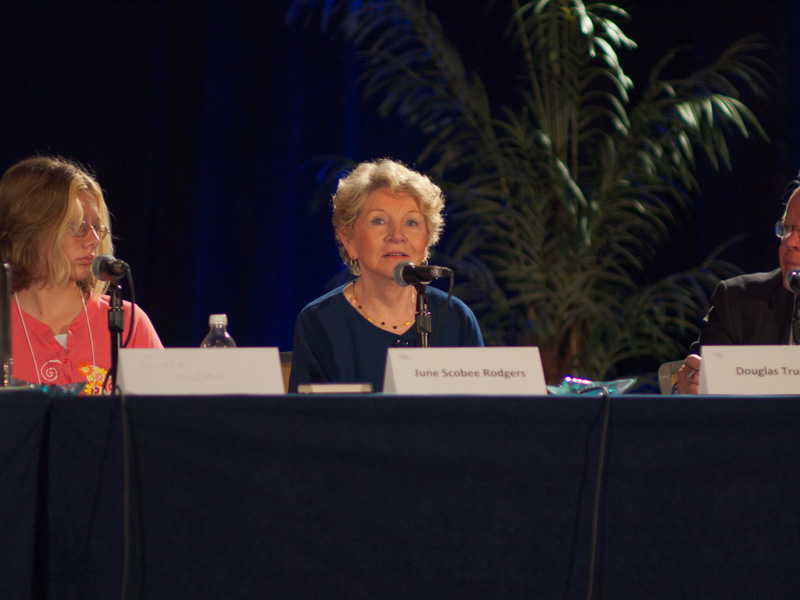 1. ISO 400, ƒ/1.4, and be there. This is the full frame—the overall quality is acceptable, although the longitudinal chromatic aberration is evident.
1. ISO 400, ƒ/1.4, and be there. This is the full frame—the overall quality is acceptable, although the longitudinal chromatic aberration is evident.
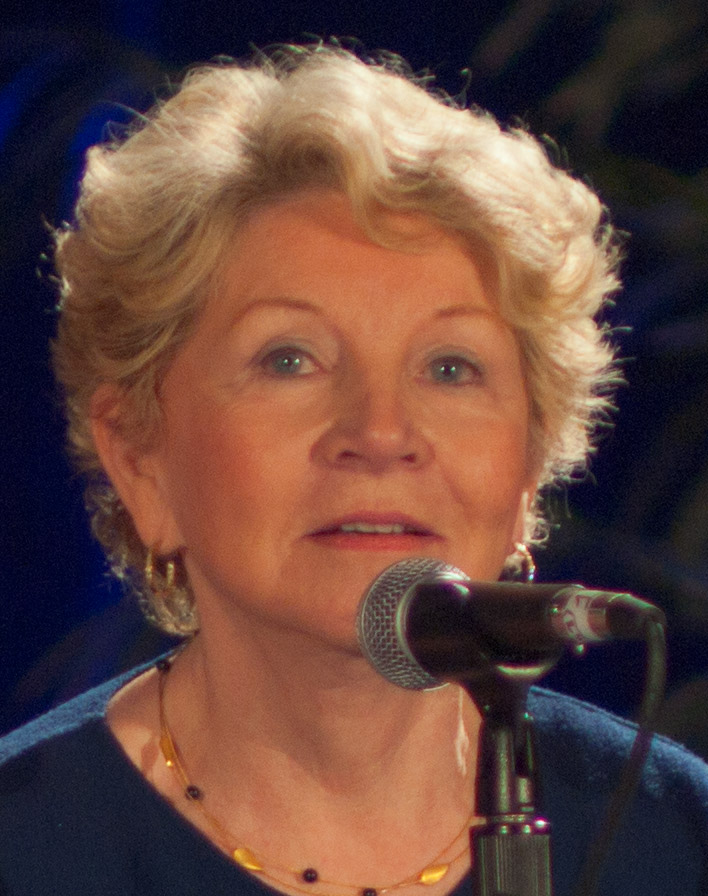 2. A 100% magnification section of the center of the field of view. Nice rendering, hazy but not fuzzy. Biggest problem is focusing
2. A 100% magnification section of the center of the field of view. Nice rendering, hazy but not fuzzy. Biggest problem is focusing
with miniscule depth of field.
For handheld work, keep image stabilization on unless you're working at really high shutter speeds. With IS, I could reliably handhold this lens at 1/40–1/50 second (reliable meaning that half my photographs came out acceptably sharp). That gets me to some pretty low-light situations without having to kick the ISO into the stratosphere. That's why wanted this lens. At high ISOs, this is one of those "if you can see it, you can photograph it" optics.
On a tripod, it definitely works better to turn image stabilization off. I got slightly wonky results on my early resolution tests until I figured that out. The results with stabilization on aren't awful, they're just less than optimal.
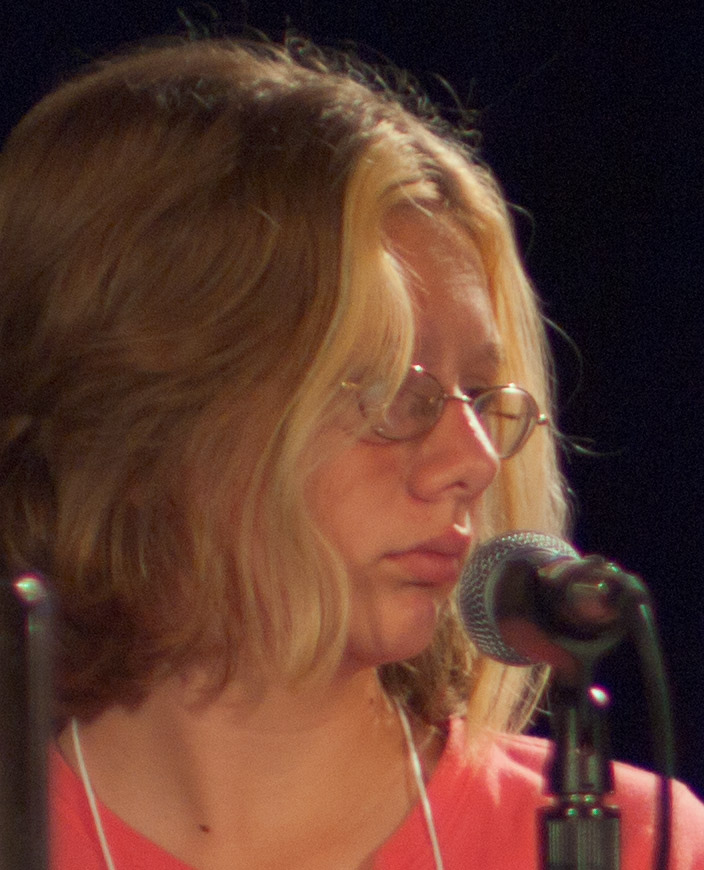 3. At 100%, the side of the frame shows the residual coma and astigmatism that smears detail out. This is under much better control at ƒ/2 and almost completely tamed at ƒ/2.8.
3. At 100%, the side of the frame shows the residual coma and astigmatism that smears detail out. This is under much better control at ƒ/2 and almost completely tamed at ƒ/2.8.
Okay, so how does it look? Not the lens, the photographs? Wide open, the lens is entirely usable (illustrations 1 and 2). There is some residual astigmatism and coma visible at the edges but it shouldn't be too distracting (illustration 3). Vignetting, wide open, is less than half a stop center to corner (it's under a quarter-stop at ƒ/2). There's almost no lateral chromatic aberration; that's impressive. On the other hand, there is a great deal of longitudinal chromatic aberration. You can see that in illustration 1 by looking at the bright highlights in front of and behind the plane of focus. Notice how the highlights on the glass tray have a pronounced magenta fringe while the highlights on the plants in the background are a pronounced green (and, no, that's not due to the color of the leaves; it's equally prominent in subjects with neutral background highlights). This is what mostly contributes to the softness of the lens wide open. It's not an unpleasant softness, just a slight hazy quality. Really, I am comfortable using this lens at ƒ/1.4 if I have to.
4. and 5. One of my test images. Above, full-frame. Below, the upper-right corner at 100% magnification at various apertures.
By ƒ/2.8 uniformity across the field is much, much improved, and central sharpness has perked up; I'd call this the largest aperture for good results over the entire field (illustrations 4 and 5). Peak sharpness in the center is at ƒ/5.6, although there's very little difference between that and ƒ/8. Diffraction really doesn't take an unacceptable toll until you get beyond ƒ/11. Uniformity continues to improve as the lens is stopped down. It's very good at ƒ/5.6 and excellent at ƒ/8. If central image quality is most important, ƒ/5.6 is the optimum aperture (illustrations 6 and 7); if overall quality across the field matters more, then ƒ/8.
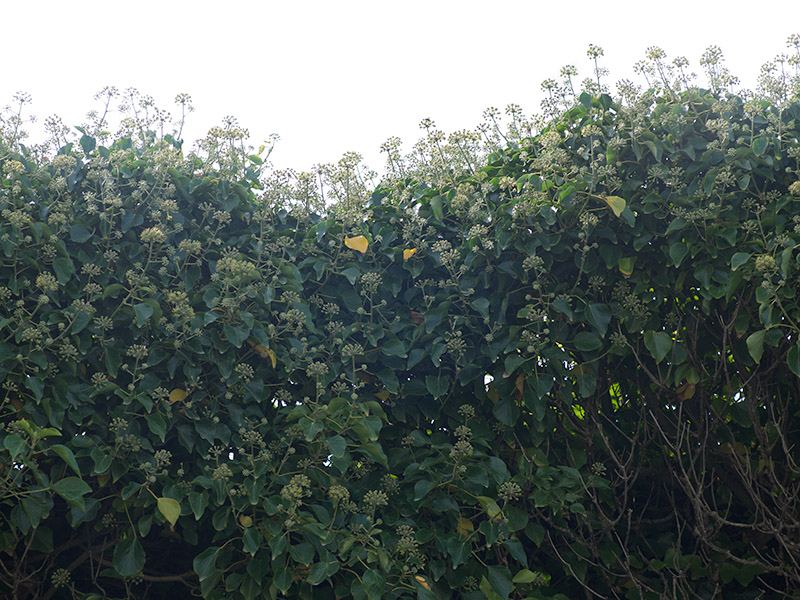 6. Flare is a major problem with this lens when there are large bright areas
6. Flare is a major problem with this lens when there are large bright areas
near the edge of the frame. It's a function of those huge front elements,
and it's only modestly improved by stopping down, as demonstrated
in this image made at ƒ/5.6.
An expected issue with a lens like this is flare, and it is present in abundance. Although a lens hood's included, any very bright areas at the edge of the field of view of the lens are going to produce significant flare, as is evident in illustration 6. No way to work around this; one just has to try to avoid such situations or live with the results.
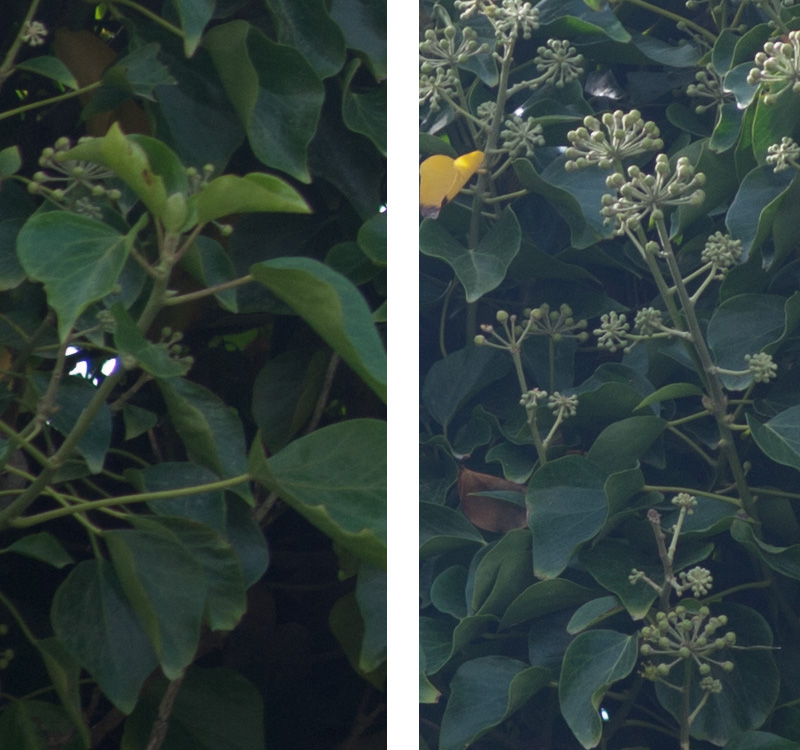 7. These are 100% sections from illustration 6. Stop ƒ/5.6 produces the best center sharpness, along with very good image quality at the edges. For optimum overall uniformity, go down another stop to ƒ/8.
7. These are 100% sections from illustration 6. Stop ƒ/5.6 produces the best center sharpness, along with very good image quality at the edges. For optimum overall uniformity, go down another stop to ƒ/8.
Overall, I'd call this a decent lens, not a spectacular performer but good enough. It's a solid keeper. Understand that that's a price-sensitive matter; if this were a $1,000 optic I'd expect a lot better than decent performance (and an automatic aperture!), and it would be back to B&H with it. At a quarter that price, I consider it a bargain. It will serve me well in low-light situations and, stopped down, I think I can do quality work with it in the outdoor daytimes.
Ctein
Ctein's regular weekly column appears on TOP on Wednesdays.
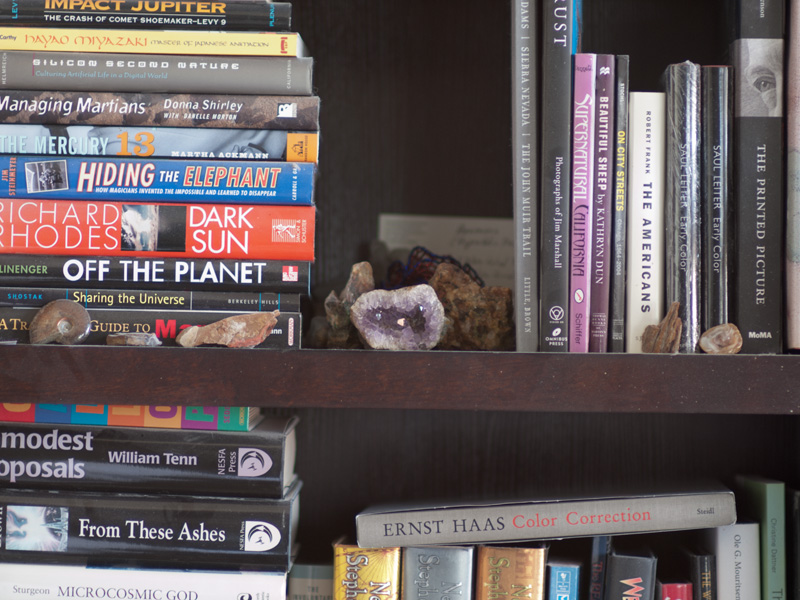
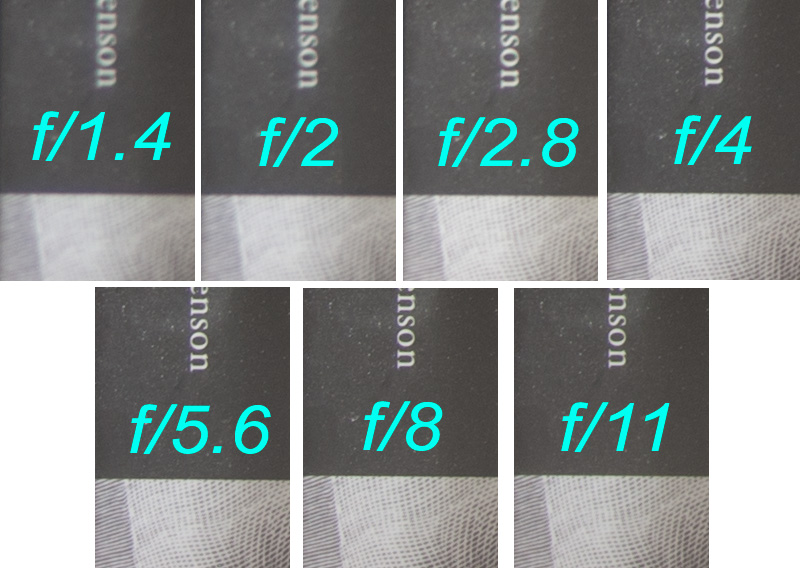

This lens is on my purchase list for my E5 too. Looks like it would be good for concerts, and I've seen some nice work with it. Thanks for the test. Looks like Rokinon is starting to make regular m43 mounts with smaller designs (a fish-eye to start) but I don't know if they have aperture control.
Posted by: John Krumm | Wednesday, 12 October 2011 at 11:07 AM
I think I must be misunderstanding something. Don't most manual focus lenses have manual aperture control?
Posted by: Andrew | Wednesday, 12 October 2011 at 11:23 AM
Thanks sharing your impression of this rather underreviewed lens. It does look like a bargain, if MF is something one doesn't mind. My Nikon 180/2.8 Ai-S served just such a role, back in the day.
Posted by: Michael Bernstein | Wednesday, 12 October 2011 at 12:20 PM
"Your search "Rokinon 85mm" did not match any products" at Amazon, Mike. "85 mm", with a space, does find all the versions.
Posted by: erlik | Wednesday, 12 October 2011 at 12:52 PM
Dear Andrew,
It's two different mechanisms. Lack of autofocus doesn't have to mean lack of auto aperture. The latter is much older and more common technology; it's been the norm for lenses for half a century.
Consequently, this should be spelled out explicitly in the specs, which I read very carefully several times to try to determine this.
pax / Ctein
Posted by: ctein | Wednesday, 12 October 2011 at 01:02 PM
Erlik,
I think I've repaired it. Linking to search pages doesn't always work; sometimes there's some kind of glitch in the code that I can't identify. For instance, a search for "Rokinon 85mm" works fine for me, but when I link it, it comes up empty.
Oh well, it should work now to link to the page for the specific lens Ctein bought. I'm sure anyone who wants to find another version is capable of doing so on their own.
Thanks for the heads up, though.
Mike
Posted by: Mike Johnston | Wednesday, 12 October 2011 at 01:07 PM
Dear Folks,
Some minor notes -- this lens is available in a variety of mounts. The one I reviewed (and Mike linked to) is the Oympus 4/3 mount, which will work directly on 4/3 cameras and with an adapter on micro-4/3 cameras. But you can get it in several other mounts.
Supposedly (according to the manual), this lens will cover a full 35mm frame. I'd not expect great edge quality in larger formats, not even stopped down. But the lens is there if you need it.
Also, the lens pictured in the Amazon ad is for a different mount than 4/5, so the aperture ring won't look quite the same on the one you buy.
pax / Ctein
Posted by: ctein | Wednesday, 12 October 2011 at 01:34 PM
Most modern lenses remain at full aperture most of the time, stopping down to the set aperture (whether set manually or by the camera's brain) just before the exposure is made. This is sometimes called "auto aperture" (or was, many decades ago, when it wasn't just taken for granted).
What Ctein seems to be describing is a scheme where the aperture ring directly and immediately controls the aperture (just like on my Cosmicar 75mm/1.4 video lens). Not very common on SLR lenses in my experience, but common elsewhere.
(There's also an intermediate stage, where the actual aperture is controlled by an easily-turned ring without click-stops, but another ring with heavy clickstops can be set to limit how far the aperture ring will stop down the lens. This is "preset aperture", and I owned a 400mm/6.3 Pentax lens that worked that way in the 1970s. With a big slow lens and an optical viewfinder you can't see anything or use your focusing aids if the lens is stopped down; this makes it easy to open for viewing and stop down to the aperture you picked for shooting without having to look or count clicks.)
Posted by: David Dyer-Bennet | Wednesday, 12 October 2011 at 02:07 PM
I wonder how this lens would compare to some older MF telephotos of similar focal length, like the Hexanon 85 mm f/1.8?
And since you mentioned it, have either of you (Ctein or Mike) received your 45 mm yet? I ordered mine in early September, and it still shows as "Backordered" from B&H.
Posted by: Nicholas Condon | Wednesday, 12 October 2011 at 02:11 PM
Ctein
Thanks for the review. I'm still trying to wrap my head around the 4:3 vs 3:2 thing. Does this post at the Fourthirdsphoto Forum make sense to you?
http://forum.fourthirdsphoto.com/showpost.php?p=573381&postcount=92
It does to me but I'm probably missing something.
Posted by: Brian Small | Wednesday, 12 October 2011 at 02:19 PM
Mike (or indeed anyone else who may know)
do B&H often close down for holidays? I only ask because on the only time I ever went to New York, one of my plans was to buy from B&H a lens that was on sale for half the UK price. When I arrived, the store was shut. It was a Tuesday or Wednesday if I recall correctly, in about mid April in 2003.
I had a nice time in New York, anyway.
Posted by: James B | Wednesday, 12 October 2011 at 02:53 PM
I've been very tempted by one of these for a while, so, thankyou for the clear review, Ctein. Here in the UK/Europe they are sold as Samyang or Falcon. I thought Samyang were the manufacturers, but I may be mistaken.
Does it help you, Mike, to have an Amazon UK link ? If so there is one here:-
http://www.amazon.co.uk/Samyang-Aspherical-Nikon-D5000-Cameras/dp/B00292J7OW/ref=sr_1_1?ie=UTF8&qid=1318451496&sr=8-1
Edit as you see fit.
Regards,
Posted by: Mark Walker | Wednesday, 12 October 2011 at 03:36 PM
"have either of you (Ctein or Mike) received your 45 mm yet?"
Nicholas,
Supposedly mine was shipped from B&H four days ago, but it hasn't turned up yet.
Mike
Posted by: Mike Johnston | Wednesday, 12 October 2011 at 03:44 PM
James,
The owners of B&H are observant Hasidic (I believe) Jews, as are most of the people who work there. They close down for virtually all orthodox Jewish holidays, as far as I know. Right now it's Succos.
I hope others will please forgive my ignorance if I've got any of the above wrong. I grew up in a neighborhood that was perhaps 50% Jewish, and in elementary school we celebrated Hannukah as much as Christmas and sang both Jewish and Christian songs at the holidays, and of course half my childhood friends were Jewish, give or take, but I'm still not up on the finer points of either religion. Or any religion, come to that.
Mike
Posted by: Mike Johnston | Wednesday, 12 October 2011 at 03:55 PM
I have this lens in Pentax K mount and its aperture is fully automatic. The specs and reviews on Amazon had led me to believe otherwise, so I was pleasantly surprised.
Posted by: Brian | Wednesday, 12 October 2011 at 04:04 PM
Ctein,
Great article. This of course being one of my favorite sites, I get a lot of information from it. My interest was immediately raised when you wrote about the Olympus E-P1 and your up-coming or possibility of a review of the 12 and 45 mm lens for the m43 cameras. I use Olympus SLRs and this summer purchased the EPL2 with the 14-45 of which quickly became my carry all the time camera. I am also thinking of getting the Rokinon Fish eye for the 4/3 mount to go with my collection.
I just finised with the DPreview comparitor link and was amazed at the way the Olympus EPL-2 and E-5 compaired with the Leica and other cameras. The Jpegs are amazing from the two Olympus I chose in the 4 frames. Using various set ups with the four frames, the E-5 and EPL cameras do very well against the Leica M-9 as well as the bigger brands flagships.
Thanks for your articles.
Mike T.
Posted by: MikeT | Wednesday, 12 October 2011 at 05:30 PM
Dear Nicholas,
When I asked B&H a week ago when they expected to get the 45 mm lens in, they checked with the supplier and was told there was still no delivery date. So I canceled my order with them and bought one from a private seller on eBay. It checks out good, but I haven't worked with it enough yet to do a review. Most likely the 12mm will be next, sometime in November.
~~~~~~
Dear Brian,
You know, I was brainstorming the other day and I came up with this marvelous idea for improving transportation efficiency. If I take a big cylinder, like a tree trunk, cut two kind-of-circular slices off it, and stick to them on the ends of a pole, I can ROLL stuff on it instead of having to drag stuff.
Isn't that great?! I think I'm going to call it "wheels". You heard it here first.
That's the import of that post.
Ever since photographic materials appeared in two different sizes with two different aspect ratios, way back in the dark ages, there have been people who will argue about how to compare the focal lengths between those to different sizes. The accepted convention, because you have to pick *something* to agree on, is to use the diagonal. That makes the scaling ratio between 35mm (a.k.a. full-frame) and micro-4/3 almost exactly a factor of 2.
Anything more than this is nitpicking; you can ignore it at your pleasure or entertain it at your peril, as you wish.
pax \ Ctein
[ Please excuse any word-salad. MacSpeech in training! ]
======================================
-- Ctein's Online Gallery http://ctein.com
-- Digital Restorations http://photo-repair.com
======================================
Posted by: ctein | Wednesday, 12 October 2011 at 08:22 PM
Dear Nicholas,
There is a review at the micro 4/3 forum that compares the Rokinon to the Canon FD 85mm f/1.8:
http://www.mu-43.com/f40/rokinon-85mm-1-4-compared-canon-fd-85-1-8-a-14482/
The reviewer thought the Rokinon was better. I have no data nor opinion on the accuracy of this review.
pax \ Ctein
[ Please excuse any word-salad. MacSpeech in training! ]
======================================
-- Ctein's Online Gallery http://ctein.com
-- Digital Restorations http://photo-repair.com
======================================
Posted by: ctein | Wednesday, 12 October 2011 at 08:36 PM
Thanks for the info Ctein.
You probably know that Photozone reviewed the 85/1.4 and three other Samyang lenses (which are re-branded with several names including Rokinon) in Canon EF mount. Here is the link:
http://www.photozone.de/canon-eos
Cheers! Jay
Posted by: Jay Frew | Wednesday, 12 October 2011 at 09:52 PM
Thank you for explaining so clearly crop factors for Brian. I looked at that bit of puffery he linked to and thought the poster was just too full of himself. I've been dealing with crop factor for over 35 years having both Olympus OM and Pen F cameras. Personally I prefer a 3:4 aspect ratio but to each their own. Some get along wonderfully with an XPan and others wouldn't give up their 6X6 for anything else.
How do you mount this rig on a tripod? Looking at these little cameras I would cringe at the leverage on the tripod bush when hanging a one and half pound lens on the front. Are they sturdier than they look?
Posted by: John Robison | Wednesday, 12 October 2011 at 10:33 PM
Well, personally I really liked Brian's link. I thought it was a cogent explanation of something I've been asserting myself since forever--that APS-C and 4/3 really aren't much different.
Mike
Posted by: Mike Johnston | Wednesday, 12 October 2011 at 11:14 PM
Brian,
Regardless of what Ctein and James say, I thought that was an interesting point about 4/3 sensors being effectively not any smaller than 1.6 crop sensors when printed at standard sizes . Would make me more willing to shift format than I was previously.
Richard
Posted by: Richard K | Thursday, 13 October 2011 at 04:24 AM
I've tried an AF Nikkor 85mm 1:1.8 D lately on my E-520 (regular 4/3rds) camera, see http://wolfgang.lonien.de/2011/10/schwarzweiss-und-ein-fremdobjektiv/ (the two color photos). This Samyang (Rokinon/Vivitar/Bowens/Walimex pro) lens would be both cheaper and faster, and some people on the Olympus SLR forum at DPReview have some very good images taken with those fully open. The Nikkor OTOH would autofocus on a Nikon body of course, so I'm still thinking about which one to get.
BTW, my OM Zuiko 1.8 50mm is manual aperture as well - if I stop it down, it stops down immediately, and the picture in the viewfinder gets darker. On the LCD, you can work around that of course with the "Live view boost".
Thanks for the review, ctein!
Posted by: Wolfgang Lonien | Thursday, 13 October 2011 at 04:45 AM
Dear Mike and Richard,
Anyone can figure out that there's not that much difference in the two formats by simply looking at a diagram of the sensor dimensions. Vis: http://en.wikipedia.org/wiki/Four_Thirds_system#Sensor_size_and_aspect_ratio
Even the normal scaling factor for lenses, based on the diagonal tells you that; there's about a 25% difference in the scaling factor. That's because, surprise surprise, about a 25% difference in the sensor dimensions. That is not an earthshaking difference. It's observable; it's not profound. (Almost all aspects of image quality scale to the linear dimension, not the area––people who compare areas of film or sensors are getting it wrong and exaggerating the differences. The only aspect that may scale with area is ISO, but the noise at a particular ISO scales linearly, not areally.)
But getting into fabulous arguments about exactly what scaling factor should be used? That's a brain-dead waste of time, like it's been for the past century.
If you look at the whole thread that that one post is embedded in, it's no better nor worse than most of them. I didn't say the guy was bad for writing it; that was someone else's comment, and I strongly disapprove of its ad hominem nature. But the whole thread is one long “We're going to argue about how many angels dance on the head of a pin, but first we're going to argue about the shape of the head of the pin.”
Truly a waste of time.
I say relegate this all to the trash heap, never to be spoken of again. It can sit next to the depth of field debates and keep it company.
pax \ Ctein
[ Please excuse any word-salad. MacSpeech in training! ]
======================================
-- Ctein's Online Gallery http://ctein.com
-- Digital Restorations http://photo-repair.com
======================================
Posted by: ctein | Thursday, 13 October 2011 at 12:17 PM
Dear Jay,
No, I hadn't known about the Photozone review. Thanks for the link. I've read it over and we seem to be pretty much in agreement about the lens except for a couple of points. They seemed happy with the build quality; hopefully they know more about this than I do (not an area of expertise for me). I'd certainly like it if this lens was more robust than I guessed.
They reported significantly more vignetting than I found. Here, I'm confident of my results. Don't know if it's because of the difference in experimental protocols or sample variation. If this is an issue readers are sensitive to, the safest course might be to average our two results (under the theory that two wrongs make a right).
They also observed a fair amount of focus shift as the lens is stopped down, due to residual spherical aberration. That would hardly be a surprise with a lens of this type. I missed it, and so I didn't refocus the lens as I did my stop-down tests. My bad. Mind you, the amount of shift is not huge; the improved depth of field as you stop down more than makes up for it. It means that the lens actually performs a bit better on-axis, stopped down, than I reported. Also makes the manual aperture less of a fail, since for very best sharpness you'd want to be focusing at the working aperture.
pax \ Ctein
[ Please excuse any word-salad. MacSpeech in training! ]
======================================
-- Ctein's Online Gallery http://ctein.com
-- Digital Restorations http://photo-repair.com
======================================
Posted by: ctein | Thursday, 13 October 2011 at 01:31 PM
Interestingly it wasn't the size comparison of the two sensors that interested me per se. I've been using Olympus dslrs for years and am happy with the technical aspects of the 4/3 standard. I linked to that particular forum post because it seemed to explain why my 4/3 lenses didn't actually perform like lenses of 2x the focal length on my 35mm film cameras. I have always preferred the perspective produced by a focal length of around 50mm full-frame equivalent. Reading Cteins' and just about everyone else's take on the subject means that I should be happy with a 25mm focal length on my E-3, but I'm not. I have intuitively found that I prefer a 30-35mm focal length on my 4/3 cameras and Ned's post on the Fourthirds Photo forum seemed to explain why. If the working crop factor for 4/3 systems is actually around 1.6x and not the universally stated 2x then my 25mm lens preforms more like a 40mm full-frame equivalent. At least were perspective is concerned. The difference in the format ratios screws any comparison of field of view. Am I nit-picking? Maybe, but I've seen many esteemed members of the photo community fuss over smaller differences in focal length than 10mm.
Posted by: Brian Small | Friday, 14 October 2011 at 12:59 AM
I say relegate this all to the trash heap, never to be spoken of again. It can sit next to the depth of field debates and keep it company.
Ctein, that gave me a good chuckle, an audible one, not a internet one. Thanks.
Will
Posted by: Will Frostmill | Friday, 14 October 2011 at 03:30 PM
I bought this lens after reading Ctein's article. I am happy with it. Thanks Ctein.
Posted by: P Larry Creel | Saturday, 22 October 2011 at 11:07 AM